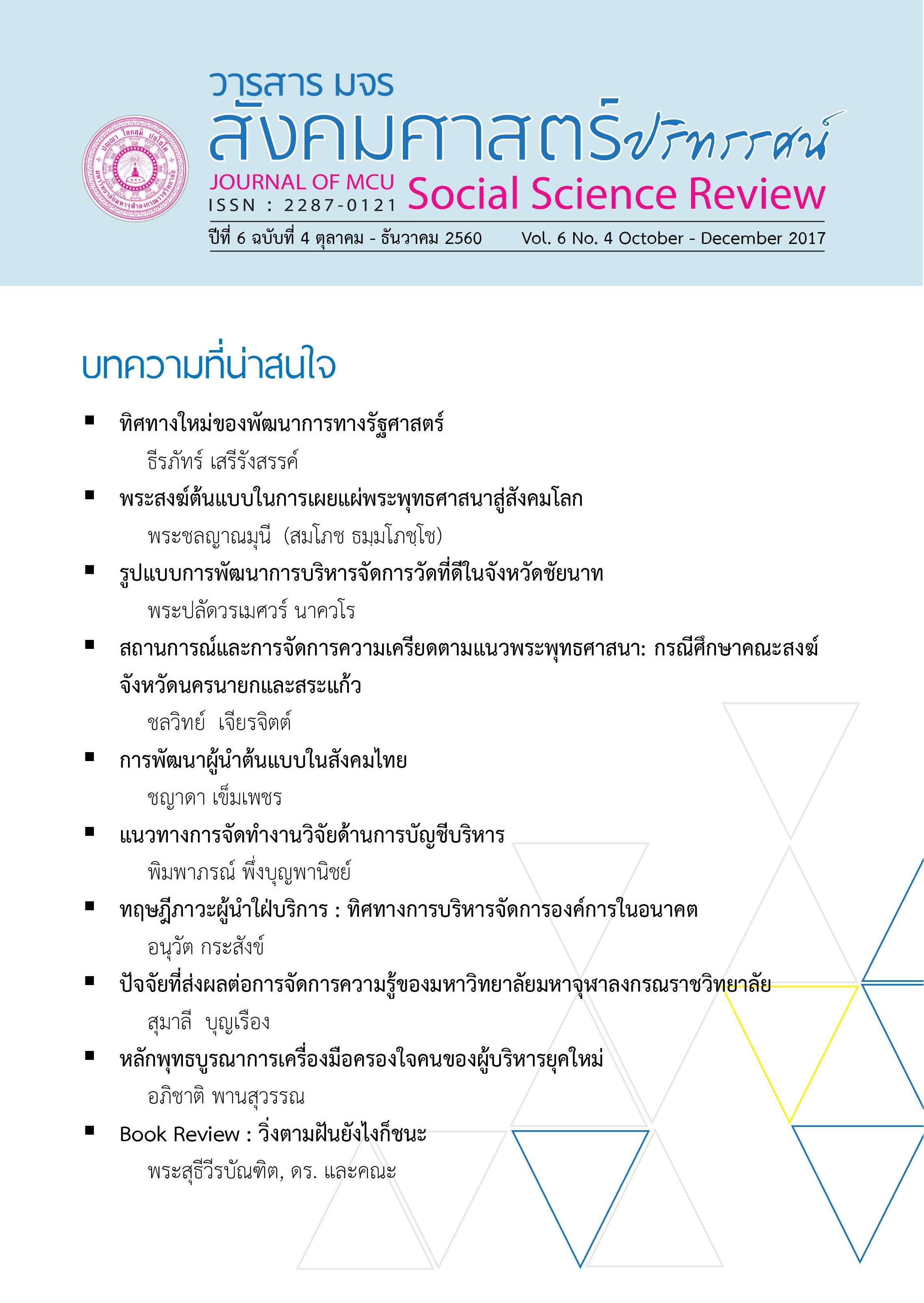พระสงฆ์ต้นแบบในการเผยแผ่พระพุทธศาสนาสู่สังคมโลก
คำสำคัญ:
พระสงฆ์ต้นแบบ, การเผยแผ่พระพุทธศาสนาบทคัดย่อ
บทความวิจัยนี้มีวัตถุประสงค์ คือ 1) เพื่อศึกษาอัตลักษณ์การเผยแผ่ของพระสงฆ์ในสังคมไทย 2) เพื่อศึกษากระบวนการการเผยแผ่ของพระสงฆ์ต้นแบบ ในการเผยแผ่พระพุทธศาสนา สู่สังคมโลก 3) เพื่อนำเสนอต้นแบบของพระสงฆ์ที่ประสบความสำเร็จ ในการเผยแผ่พระพุทธศาสนา สู่สังคมโลก การวิจัยฉบับนี้ เป็นการวิจัยเชิงคุณภาพ (Qualitative Research) ใช้หลักการวิเคราะห์เนื้อหา (Content Analysis) คือ การกระทำกับข้อมูลที่ได้จากเอกสาร และจากผู้ให้ข้อมูลสำคัญจำนวน 25 รูปหรือคน ด้วยแบบสัมภาษณ์เชิงลึก แบบมีโครงสร้าง และการสนทนากลุ่มเฉพาะ (Focus Group Discussion) ผู้ทรงคุณวุฒิ จำนวน 12 รูปหรือคน วิเคราะห์ข้อมูลเชิงพรรณนา (Descriptive Analysis)
ผลการวิจัยพบว่า
1) อัตลักษณ์ของการเผยแผ่ของพระสงฆ์ในสังคมไทย พบว่า พระสงฆ์ในสังคมไทยมีวัตถุประสงค์ จุดมุ่งหมายของการสอนการเผยแผ่ คือ การนำหลักธรรมที่ศึกษาปฏิบัติมาเผยแผ่ โดยการยกหัวข้อธรรมขึ้นแสดง (เทศนา) เพื่อสั่งสอนประชาชนให้รู้และเข้าใจอย่างถูกต้องมีเหตุผล เพื่อละชั่ว ทำดี มีความสุขสงบ มีสันติ หรือถึงนิพพานอันเป็นจุดสูงสุดของชีวิตในทัศนคติทางพระพุทธศาสนา แต่พระสงฆ์ในสังคมไทยส่วนใหญ่เน้นสอนเรื่องทานเป็นลำดับแรกต่อด้วยศีล และภาวนาสุดท้าย หลักการและวิธีการในเผยแผ่หลักธรรมมีความหลากหลายวิธี รวมถึงการปฏิบัติตนในการเผยแผ่ศาสนามีความแตกต่างกันไปตามสภาวะของผู้ปฏิบัติ
2) กระบวนการการเผยแผ่ของพระสงฆ์ต้นแบบ พบว่า ในการเผยแผ่พระพุทธศาสนาสู่สังคมโลกนั้น เปิดโอกาสให้ประชาชนทุกระดับชั้น ทุกชาติทุกภาษาได้รับการศึกษาอย่างทั่วถึงกัน ซึ่งเป็นกลวิธีที่แสดงให้ประชาชนในสังคมโลกได้รับทราบเรื่องราวต่างๆ จากการดำเนินงาน เช่น การผลิตบุคลากร ให้มีความพร้อมทั้งร่างกายและจิตใจ มีการศึกษาวิชาการทางพุทธศาสนา พร้อมทั้งฝึกฝนตนเองอย่างแตกฉานก่อน (วิชาจรณสัมปันโน) มีการผลิตสื่อเพื่อใช้ในการเผยแผ่ที่เข้าใจง่าย มีการประยุกต์พุทธวิธีในการเผยแผ่ คือ นำหลักธรรมคำสอนของพระพุทธเจ้ามาปรับใช้ในการสอนให้เข้ากับยุคสมัยปัจจุบัน โดยยึดหลักธรรมวินัยของพระพุทธเจ้าเป็นแบบอย่าง แล้วนำมาอบรมสั่งสอนพุทธบริษัทให้นำหลักธรรมไปประพฤติปฏิบัติในชีวิตประจำวัน เช่น เน้นสอนเรื่องภาวนาเป็นลำดับแรก ต่อด้วยศีล และทานสุดท้าย ซึ่งเป็นกระบวนการการเผยแผ่ของพระสงฆ์ต้นแบบ ในการเผยแผ่พระพุทธศาสนาสู่สังคมโลก ที่ประสบความสำเร็จในการเผยแผ่พระพุทธศาสนาของทั้ง 2 ท่าน ได้แก่ พระธรรมมงคลญาณ (วิริยังค์ สิรินฺธโร) และพระภาวนาวิเทศ (เขมธมฺโม ภิกฺขุ) ที่มีผลงานปรากฏและเป็นที่ยอมรับต่อสาธารณชนทั้งในประเทศและต่างประเทศ ช่วยให้ผู้ศึกษาพระพุทธศาสนาเกิดความรู้ความเข้าใจวิธีการ สามารถนำรูปแบบไปพัฒนาชีวิตในทิศทางที่ถูกต้อง อันจะเกิดประโยชน์ต่อตนเอง ประเทศชาติ ต่อสังคมโลก
3) ต้นแบบของพระสงฆ์ที่ประสบความสำเร็จ ในการเผยแผ่พระพุทธศาสนาสู่สังคมโลก พบว่า ในการเผยแผ่พระพุทธศาสนาสู่สังคมโลกของพระธรรมมงคลญาณ (วิริยังค์ สิรินฺธโร) และ พระภาวนาวิเทศ (เขมธมฺโม ภิกฺขุ) โดยยึดหลักธรรมกถึกหรือธรรมะสำหรับนักเผยแผ่ 5 ประการ คือ 1) แสดงหลักธรรมหรือเนื้อหาวิชาตามลำดับความง่ายยากลุ่มลึก มีเหตุผลสัมพันธ์ต่อเนื่องกันไปโดยลำดับ 2) ชี้แจงยกเหตุผลมาแสดงให้เข้าใจ คือ ชี้แจงให้เข้าใจชัดในแต่ละแง่แต่ละประเด็น โดยอธิบายขยายความ ยักเยื้องไปต่างๆ ตามแนวเหตุผล 3) แสดงธรรมด้วยอาศัยเมตตา คือ สอนเขาด้วยจิตเมตตา มุ่งจะให้เป็นประโยชน์แก่เขา 4) ไม่แสดงธรรมด้วยเห็นแก่อามิส คือ สอนเขามิใช่เพราะมุ่งที่ตนจะได้ลาภ หรือผลประโยชน์ตอบแทน 5) แสดงธรรมไม่กระทบตนและผู้อื่น คือ สอนตามหลักตามเนื้อหา มุ่งแสดงธรรม แสดงธรรม ไม่ยกตน ไม่เสียดสีข่มขี่ผู้อื่น สิ่งที่ท่านมุ่งเน้นการปฏิบัติตน โดยมีศีลาจริยวัตรอย่างเคร่งครัดงดงาม นับว่า เป็นคุณสมบัติภายนอกที่เกิดศรัทธาต่อผู้พบเห็น นอกเหนือจากคุณสมบัติทางกายภาพ มีการศึกษาศึกษาค้นคว้าวิชาการต่างๆ มีความรู้ความเข้าใจอย่างดี ถือว่าเป็นคุณสมบัติภายใน รวมถึงการการประยุกต์ใช้สื่อเทคโนโลยีสารสนเทศ ในการเผยแผ่พระพุทธศาสนาให้เข้ากับยุคสมัย
เอกสารอ้างอิง
Chandradhar Sharma. (1991). A Critical Survey of Indian Philosophy.8th ed., (Delhi: Motilal Banarsidass.
Heinrich Zimmer. (1956). Philosophies of India. New York: Meridian Books.
Mahachulalongkornrajavidyalaya University. Pali Tripitaka. The Rules Reflect Mahachula Tepic. 2500. Bangkok's Chulalongkorn University Printing College, 1992.
Monier Williams. (1920) .A Sanskrit English Dictionary. Revised Edition. USA : Oxford University Press.
Phra Brahmagunabhorn (P.A.Payutto). (2005). Thai Buddhism in the Buddhist World. Bangkok: Mahachulalongkornrajavidyalaya.
Phramaha Boonchuay Sirindharo. (2004). “Application of the Buddha’s Teaching in Socialization by Family in Strengthened community for Prevention and Reduction of Drug Abuse among the Youth”. A Research Report, the Institute of Buddhism. Ergonomics: Mahachulalongkornrajavidyalaya University.
Samuel George Frederick Brandon. (1970). A Dictionary of Comparative Religion. New York: Scribner.
Somparn Promta. (2003). Human and Buddhism. Bangkok: Sayam.
Tinnapan Nakata. (2001). Buddhism and Thai Society. Bangkok: Sahai Block& Printing.
Tinnapan Nakata. (1986). The Monastics Role in Society Monks. Bangkok : Aksorn Charoen Tat.
Venerable Phra Dhammapitaka (P.A. Payutto). (1998). Buddhist Teaching Methods. Bangkok: Sahathammik Co., (2004).
ดาวน์โหลด
รูปแบบการอ้างอิง
ฉบับ
ประเภทบทความ
สัญญาอนุญาต
ลิขสิทธิ์ (c) 2017 วารสาร มจร สังคมศาสตร์ปริทรรศน์

อนุญาตภายใต้เงื่อนไข Creative Commons Attribution-NonCommercial-NoDerivatives 4.0 International License.
เพื่อให้เป็นไปตามกฎหมายลิขสิทธิ์ ผู้นิพนธ์ทุกท่านต้องลงลายมือชื่อในแบบฟอร์มใบมอบลิขสิทธิ์บทความให้แก่วารสารฯ พร้อมกับบทความต้นฉบับที่ได้แก้ไขครั้งสุดท้าย นอกจากนี้ ผู้นิพนธ์ทุกท่านต้องยืนยันว่าบทความต้นฉบับที่ส่งมาตีพิมพ์นั้น ได้ส่งมาตีพิมพ์เฉพาะในวารสาร มจร สังคมศาสตร์ปริทรรศน์ เพียงแห่งเดียวเท่านั้น หากมีการใช้ภาพหรือตารางหรือเนื้อหาอื่นๆ ของผู้นิพนธ์อื่นที่ปรากฏในสิ่งตีพิมพ์อื่นมาแล้ว ผู้นิพนธ์ต้องขออนุญาตเจ้าของลิขสิทธิ์ก่อน พร้อมทั้งแสดงหนังสือที่ได้รับการยินยอมต่อบรรณาธิการ ก่อนที่บทความจะได้รับการตีพิมพ์ หากไม่เป็นไปตามข้อกำหนดเบื้องต้น ทางวารสารจะถอดบทความของท่านออกโดยไม่มีข้อยกเว้นใดๆ ทั้งสิ้น





